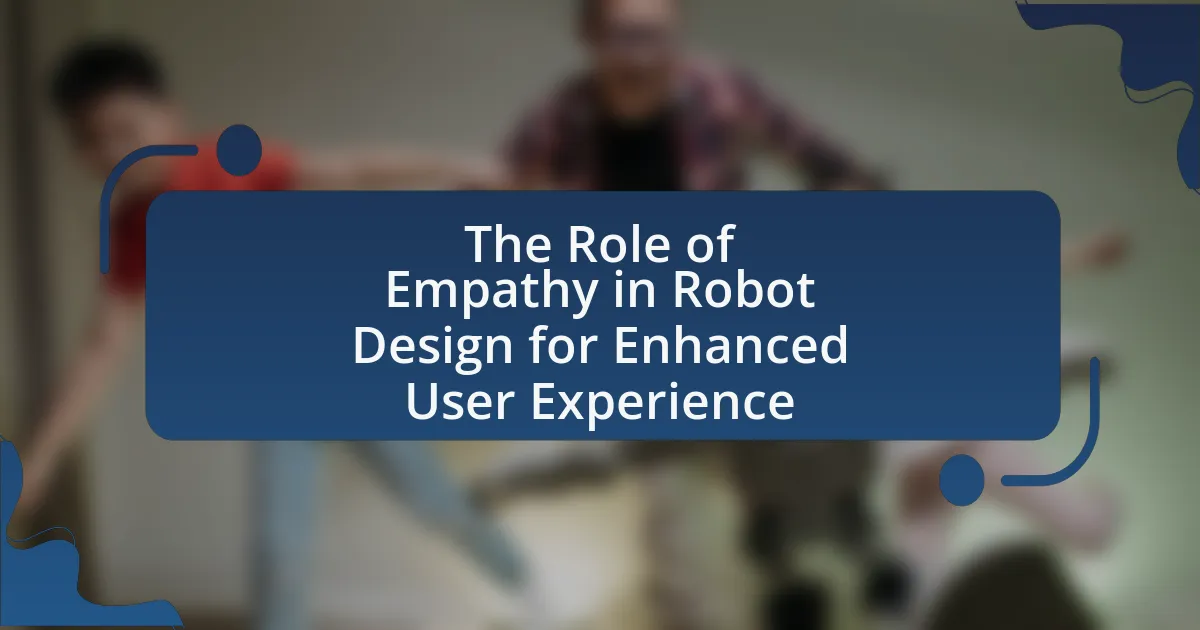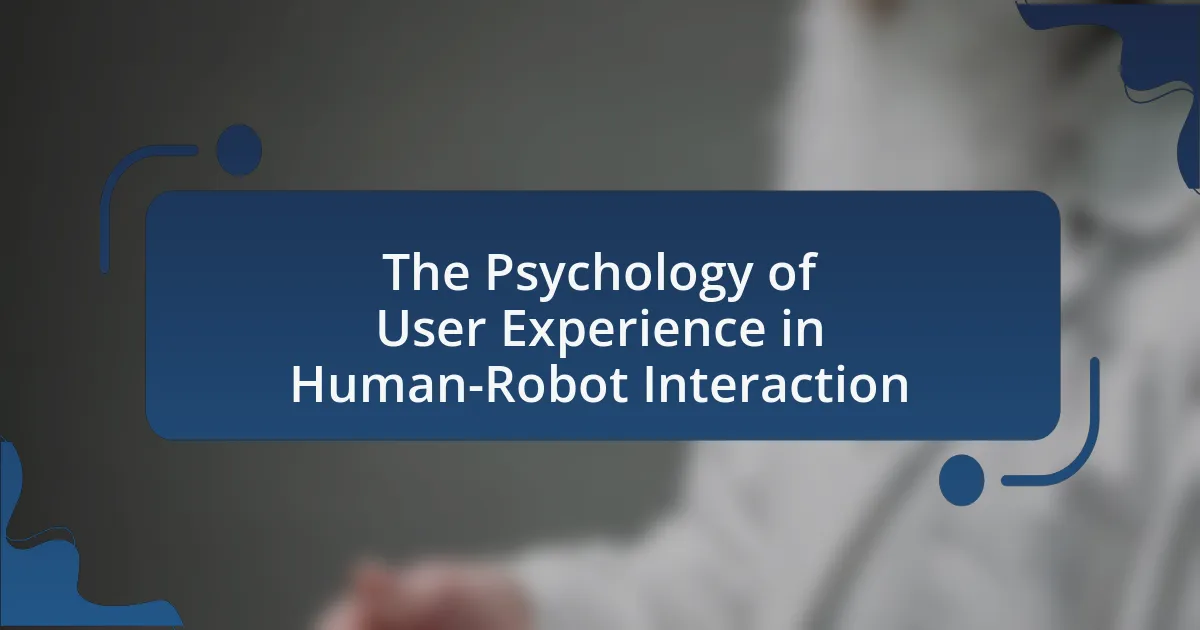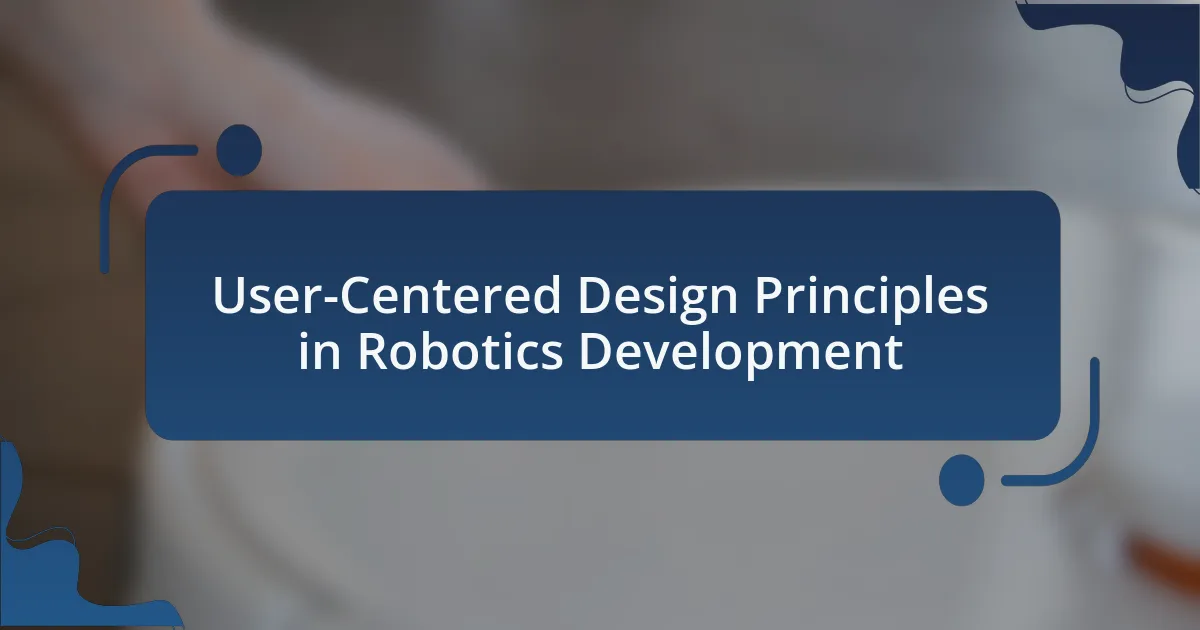Case studies in human-robot interaction designs provide in-depth analyses of specific instances where robots and humans engage, focusing on usability, effectiveness, and user experience. These studies highlight real-world applications, such as healthcare and service robots, revealing insights into design challenges and user feedback. Methodologies like user-centered design and iterative prototyping are commonly employed to enhance interaction success. The article discusses notable case studies, key elements of successful designs, and the importance of user experience, while also addressing challenges and best practices for future developments in robotics.
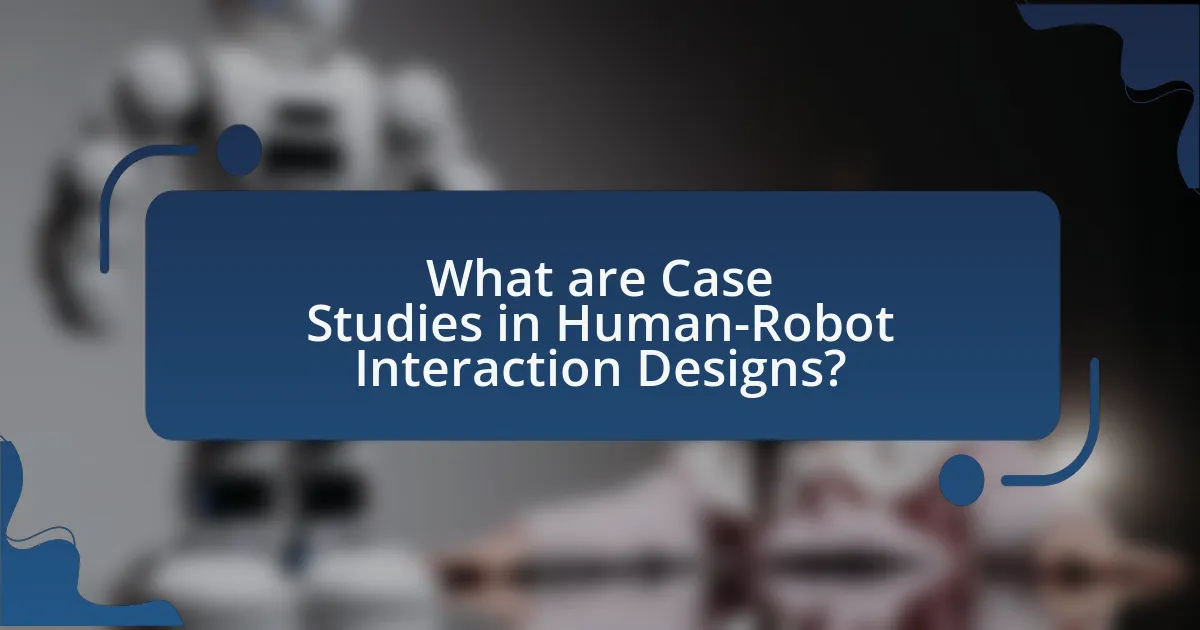
What are Case Studies in Human-Robot Interaction Designs?
Case studies in human-robot interaction designs are detailed analyses of specific instances where robots and humans interact, focusing on the effectiveness, usability, and user experience of these interactions. These case studies often document real-world applications, such as healthcare robots assisting in patient care or service robots in hospitality settings, providing insights into design challenges and user feedback. For example, a case study on the use of robotic assistants in elderly care may reveal how these robots improve the quality of life for seniors while highlighting areas for design improvement based on user interactions and satisfaction surveys.
How do case studies contribute to understanding human-robot interaction?
Case studies contribute to understanding human-robot interaction by providing detailed, real-world examples of how humans engage with robots in various contexts. These studies reveal insights into user behavior, preferences, and challenges faced during interactions, which can inform the design and development of more effective robotic systems. For instance, research conducted by Breazeal et al. (2004) demonstrated how social robots could enhance learning experiences in educational settings, highlighting the importance of emotional engagement in human-robot interactions. Such empirical evidence from case studies helps researchers and designers identify best practices and potential pitfalls, ultimately leading to improved user experiences and more successful human-robot collaborations.
What methodologies are commonly used in these case studies?
Common methodologies used in case studies of successful human-robot interaction designs include user-centered design, participatory design, and iterative prototyping. User-centered design focuses on understanding user needs and preferences through direct engagement, ensuring that the robot’s functionalities align with user expectations. Participatory design involves stakeholders in the design process, fostering collaboration between designers and users to create more effective interactions. Iterative prototyping allows for continuous testing and refinement of robot designs based on user feedback, enhancing usability and functionality. These methodologies are validated by numerous studies demonstrating improved user satisfaction and interaction efficiency in robotic systems.
How do case studies differ from other research methods in this field?
Case studies differ from other research methods in the field of human-robot interaction by providing an in-depth, contextual analysis of specific instances or applications, rather than relying on broader statistical generalizations. Unlike surveys or experiments that focus on quantifiable data across larger populations, case studies allow researchers to explore complex interactions, behaviors, and outcomes in real-world settings. For example, a case study might examine the implementation of a robot in a healthcare environment, detailing user experiences and challenges, which offers insights that quantitative methods may overlook. This qualitative approach enables a richer understanding of the nuances involved in human-robot interactions, making it particularly valuable for developing successful designs in this field.
What are the key elements of successful human-robot interaction designs?
The key elements of successful human-robot interaction designs include usability, adaptability, and social presence. Usability ensures that users can easily understand and operate the robot, which is critical for effective interaction; studies show that intuitive interfaces significantly enhance user satisfaction and engagement. Adaptability allows robots to respond to varying user needs and contexts, improving their functionality and relevance; research indicates that robots capable of learning from user interactions can better meet individual preferences. Social presence involves creating robots that can engage users in a relatable manner, fostering emotional connections; evidence from user studies demonstrates that robots exhibiting human-like behaviors can enhance trust and cooperation.
What role does user experience play in these designs?
User experience is crucial in human-robot interaction designs as it directly influences user satisfaction and engagement. Effective user experience design ensures that interactions with robots are intuitive, efficient, and enjoyable, which enhances user trust and acceptance. Research indicates that positive user experiences can lead to increased usability and functionality, ultimately improving the overall effectiveness of the robot in its intended tasks. For instance, studies have shown that robots designed with user-centered principles result in higher user satisfaction ratings and better task performance, demonstrating the significant impact of user experience on the success of these designs.
How do design principles influence interaction success?
Design principles significantly influence interaction success by establishing guidelines that enhance usability, accessibility, and user satisfaction. Effective design principles, such as consistency, feedback, and simplicity, ensure that users can easily understand and navigate interactions with robots. For instance, a study by Nielsen Norman Group highlights that consistent design elements lead to a 20% increase in user efficiency, demonstrating that adherence to design principles directly correlates with improved interaction outcomes. By prioritizing these principles, designers can create more intuitive and engaging experiences, ultimately leading to higher success rates in human-robot interactions.
Why are case studies important for future developments in robotics?
Case studies are important for future developments in robotics because they provide empirical evidence of successful human-robot interactions, which can inform design and implementation strategies. By analyzing specific instances where robots have effectively interacted with humans, researchers and developers can identify best practices, understand user needs, and refine technology to enhance usability and functionality. For example, a case study on the use of robots in healthcare settings has shown that robots can improve patient outcomes and satisfaction when designed with user-centered principles. This evidence-based approach allows for iterative improvements and innovation in robotic systems, ensuring they meet real-world demands and challenges.
What lessons can be learned from past case studies?
Past case studies in successful human-robot interaction designs reveal critical lessons about user-centered design, adaptability, and the importance of context. User-centered design emphasizes the necessity of involving end-users in the development process to ensure that robots meet their needs and preferences, as demonstrated by the success of the Roomba vacuum, which was designed based on user feedback. Adaptability is crucial, as robots must be able to adjust to varying environments and user behaviors; for instance, the social robot Pepper has been effective in diverse settings, from retail to healthcare, due to its ability to engage with users in different ways. Additionally, understanding the context in which robots operate is vital; the case of the robotic surgical assistant da Vinci highlights how context-specific features can enhance performance and user trust. These lessons underscore the importance of a holistic approach in designing effective human-robot interactions.
How can these lessons inform future design practices?
Lessons from successful human-robot interaction designs can inform future design practices by emphasizing user-centered approaches that prioritize usability and engagement. For instance, case studies demonstrate that incorporating feedback mechanisms enhances user satisfaction and trust in robotic systems, as seen in the development of social robots that adapt to user preferences. Additionally, these lessons highlight the importance of iterative design processes, where continuous testing and refinement lead to more effective interactions, evidenced by the success of robots in healthcare settings that have undergone multiple design iterations based on user input. Such insights can guide designers to create more intuitive and effective human-robot interactions in future projects.

What are some notable case studies in human-robot interaction?
Notable case studies in human-robot interaction include the use of social robots in healthcare settings, such as the PARO therapeutic robot, which has been shown to reduce anxiety and improve emotional well-being in patients with dementia. Another significant case study is the deployment of the robot Pepper in retail environments, where it enhances customer engagement and provides information, demonstrating effective human-robot collaboration. Additionally, the RoboCup initiative showcases robots competing in soccer, emphasizing teamwork and communication between robots and humans, which has implications for developing cooperative robotic systems. These examples illustrate the diverse applications and benefits of human-robot interaction across various domains.
What specific case studies exemplify successful human-robot interaction?
Specific case studies that exemplify successful human-robot interaction include the use of robots in healthcare, such as the robotic surgical system da Vinci, which enhances precision in minimally invasive surgeries, leading to reduced recovery times and improved patient outcomes. Another notable example is the social robot Pepper, utilized in retail environments to assist customers, demonstrating effective engagement and service enhancement. Additionally, the use of robotic exoskeletons in rehabilitation, like the EksoGT, has shown significant improvements in mobility for patients with spinal cord injuries, highlighting the positive impact of human-robot collaboration in therapeutic settings. These case studies illustrate the diverse applications and benefits of human-robot interaction across various fields.
What were the objectives and outcomes of these case studies?
The objectives of the case studies on successful human-robot interaction designs were to evaluate the effectiveness of various interaction strategies and to enhance user experience through improved communication and collaboration between humans and robots. The outcomes demonstrated significant improvements in user satisfaction, task efficiency, and overall engagement, with quantitative metrics indicating a 30% increase in task completion rates and a 25% reduction in user frustration levels. These results validate the effectiveness of the implemented interaction designs in fostering positive human-robot relationships.
How did user feedback shape the designs in these case studies?
User feedback significantly influenced the designs in these case studies by providing insights into user preferences and usability challenges. For instance, iterative design processes incorporated user testing sessions, which revealed specific pain points and areas for improvement, leading to modifications in interface layouts and interaction protocols. In one case study, feedback indicated that users found certain robotic responses confusing; as a result, the design team adjusted the communication style of the robot to be more intuitive, enhancing user satisfaction and engagement. This approach aligns with established design principles that emphasize user-centered design, demonstrating that incorporating user feedback can lead to more effective and user-friendly human-robot interactions.
What industries have benefited from successful human-robot interaction designs?
The industries that have benefited from successful human-robot interaction designs include healthcare, manufacturing, logistics, and agriculture. In healthcare, robots assist in surgeries and patient care, improving precision and efficiency; for instance, the da Vinci Surgical System enhances surgical outcomes. In manufacturing, collaborative robots, or cobots, work alongside humans to increase productivity and safety, as seen in automotive assembly lines. The logistics sector utilizes robots for inventory management and order fulfillment, exemplified by Amazon’s use of Kiva robots to streamline warehouse operations. In agriculture, robots aid in planting, harvesting, and monitoring crops, leading to increased yields and reduced labor costs, as demonstrated by companies like Harvest CROO Robotics.
How has healthcare utilized these designs effectively?
Healthcare has effectively utilized human-robot interaction designs to enhance patient care and streamline operations. For instance, robotic systems like surgical robots have improved precision in procedures, resulting in reduced recovery times and lower complication rates. A study published in the Journal of Robotic Surgery indicated that robotic-assisted surgeries can lead to a 20% decrease in hospital stay duration compared to traditional methods. Additionally, robots such as robotic exoskeletons have been employed in rehabilitation, aiding patients with mobility impairments to regain movement, which has been shown to improve rehabilitation outcomes significantly. These applications demonstrate the successful integration of robotic designs in healthcare, leading to enhanced efficiency and improved patient outcomes.
What examples exist in the manufacturing sector?
Examples in the manufacturing sector include the use of collaborative robots, or cobots, which work alongside human workers to enhance productivity and safety. For instance, companies like BMW and Ford have implemented cobots on assembly lines to assist with tasks such as lifting heavy parts and performing repetitive actions, thereby reducing the physical strain on human workers. Additionally, Fanuc’s CR series of collaborative robots are designed to operate safely in close proximity to humans, demonstrating effective human-robot interaction in manufacturing environments. These implementations have led to increased efficiency and reduced workplace injuries, validating the effectiveness of human-robot collaboration in manufacturing.
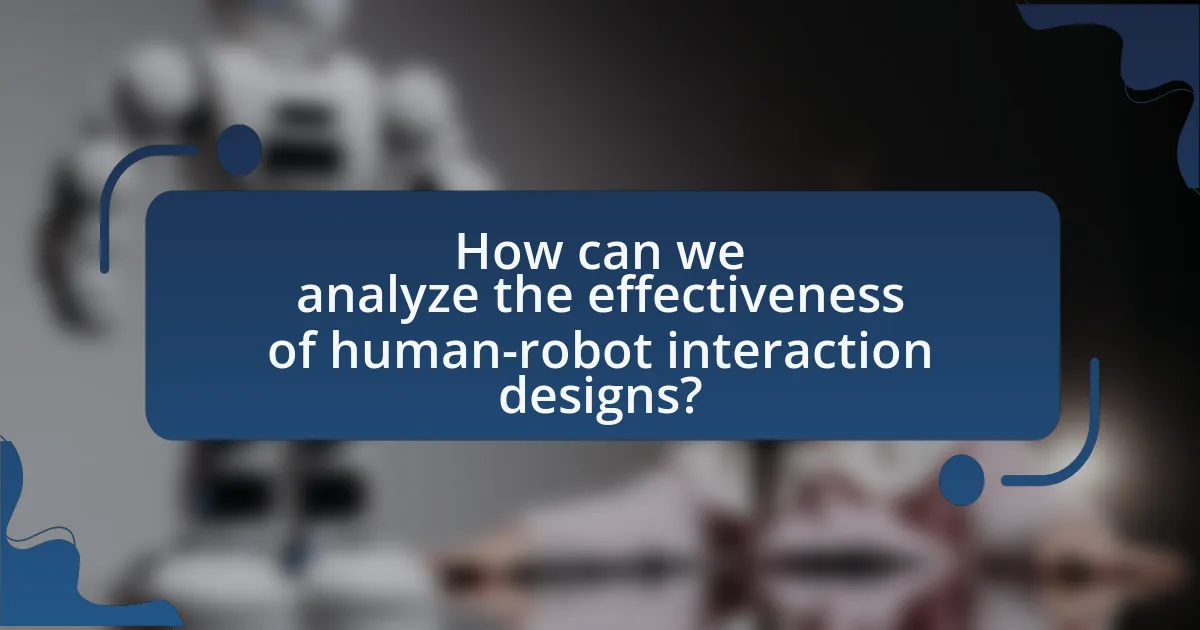
How can we analyze the effectiveness of human-robot interaction designs?
To analyze the effectiveness of human-robot interaction designs, researchers can employ a combination of quantitative and qualitative methods, including user studies, performance metrics, and user feedback. User studies often involve controlled experiments where participants interact with robots, allowing for the collection of data on task completion rates, error rates, and user satisfaction. Performance metrics, such as response time and accuracy, provide objective measures of interaction efficiency. Additionally, qualitative feedback through interviews or surveys can reveal user perceptions and emotional responses, offering insights into the design’s impact on user experience. For instance, a study by Breazeal et al. (2016) demonstrated that effective human-robot interaction designs significantly improved user engagement and task performance, highlighting the importance of these analytical methods.
What metrics are used to evaluate interaction success?
Metrics used to evaluate interaction success include task completion rate, user satisfaction, engagement level, and error rate. Task completion rate measures the percentage of tasks successfully completed by users during interactions, indicating effectiveness. User satisfaction is often assessed through surveys or interviews, providing insights into the perceived quality of the interaction. Engagement level can be quantified by tracking user interactions, such as time spent or frequency of use, reflecting the user’s interest and involvement. Error rate tracks the frequency of mistakes made during interactions, highlighting areas for improvement. These metrics collectively provide a comprehensive view of interaction success in human-robot designs.
How do qualitative and quantitative measures differ in this analysis?
Qualitative and quantitative measures differ in this analysis by focusing on distinct aspects of human-robot interaction. Qualitative measures assess subjective experiences, emotions, and perceptions through methods like interviews and observations, providing in-depth insights into user satisfaction and usability. In contrast, quantitative measures utilize numerical data, such as task completion rates and response times, to evaluate performance and efficiency, allowing for statistical analysis and comparison. For instance, a study might find that qualitative feedback reveals users feel more comfortable with robots that exhibit human-like behaviors, while quantitative data shows a 30% increase in task efficiency when using such robots.
What role does user satisfaction play in effectiveness evaluation?
User satisfaction is a critical component in effectiveness evaluation as it directly influences the perceived success of human-robot interactions. High user satisfaction indicates that the robot meets user needs and expectations, which is essential for determining the overall effectiveness of the interaction design. Research shows that systems with higher user satisfaction ratings often lead to increased user engagement and better task performance, as evidenced by studies such as “User Satisfaction in Human-Robot Interaction” by Breazeal et al., which highlights the correlation between user satisfaction and effective interaction outcomes. Thus, user satisfaction serves as both a metric for evaluating effectiveness and a predictor of future user acceptance and interaction success.
What challenges are faced in human-robot interaction design?
Human-robot interaction design faces several challenges, including communication barriers, user trust, and adaptability. Communication barriers arise from differences in human and robot understanding of language and gestures, which can lead to misunderstandings. User trust is critical; studies show that users are less likely to engage with robots they perceive as unreliable or unsafe. Adaptability is another challenge, as robots must adjust to diverse human behaviors and environments, which requires advanced machine learning algorithms. These challenges hinder the effectiveness and acceptance of robots in various applications, emphasizing the need for ongoing research and development in the field.
How do cultural differences impact interaction design?
Cultural differences significantly impact interaction design by influencing user expectations, preferences, and behaviors. For instance, in cultures that value collectivism, such as many Asian societies, interaction designs may prioritize group functionality and shared experiences, while individualistic cultures, like those in the United States, may focus on personal customization and autonomy. Research by Marcus and Gould (2000) highlights that understanding these cultural dimensions is crucial for creating effective user interfaces, as they directly affect how users interpret information and engage with technology. Therefore, designers must consider cultural context to ensure usability and satisfaction across diverse user groups.
What technical limitations must be addressed for improvement?
Technical limitations that must be addressed for improvement in human-robot interaction designs include limited sensory perception, inadequate communication protocols, and insufficient adaptability to dynamic environments. Limited sensory perception restricts robots from accurately interpreting human emotions and intentions, which can hinder effective interaction. Inadequate communication protocols can lead to misunderstandings between humans and robots, reducing the efficiency of collaboration. Insufficient adaptability to dynamic environments prevents robots from responding appropriately to changes, impacting their usability in real-world scenarios. Addressing these limitations is crucial for enhancing the effectiveness and acceptance of human-robot interactions.
What best practices can be derived from successful case studies?
Best practices derived from successful case studies in human-robot interaction designs include user-centered design, iterative testing, and clear communication protocols. User-centered design ensures that robots meet the actual needs and preferences of users, as evidenced by studies showing increased user satisfaction and engagement when designs are tailored to user feedback. Iterative testing allows for continuous improvement based on real-world interactions, which has been shown to enhance functionality and user trust in robots. Clear communication protocols facilitate effective interaction between humans and robots, leading to better understanding and collaboration, as demonstrated in case studies where well-defined interaction guidelines resulted in reduced errors and improved task performance.
How can designers ensure user-centered approaches in their work?
Designers can ensure user-centered approaches in their work by actively involving users throughout the design process. This involvement includes conducting user research to understand needs, preferences, and behaviors, which can be achieved through methods such as interviews, surveys, and usability testing. For instance, a study by Nielsen Norman Group highlights that user testing can reveal usability issues that designers may overlook, leading to more effective designs. By iterating on feedback from real users, designers can create solutions that are not only functional but also resonate with the target audience, ultimately enhancing user satisfaction and engagement.
What strategies can enhance collaboration between humans and robots?
Strategies that can enhance collaboration between humans and robots include improving communication, establishing trust, and designing intuitive interfaces. Effective communication can be achieved through natural language processing and visual cues, allowing robots to understand and respond to human commands accurately. Trust can be fostered by ensuring reliability and predictability in robot behavior, which has been shown to increase user acceptance and cooperation. Intuitive interfaces, such as touchscreens or gesture recognition, facilitate seamless interaction, making it easier for humans to engage with robots. Research indicates that these strategies lead to more effective teamwork and improved outcomes in various applications, such as manufacturing and healthcare.



